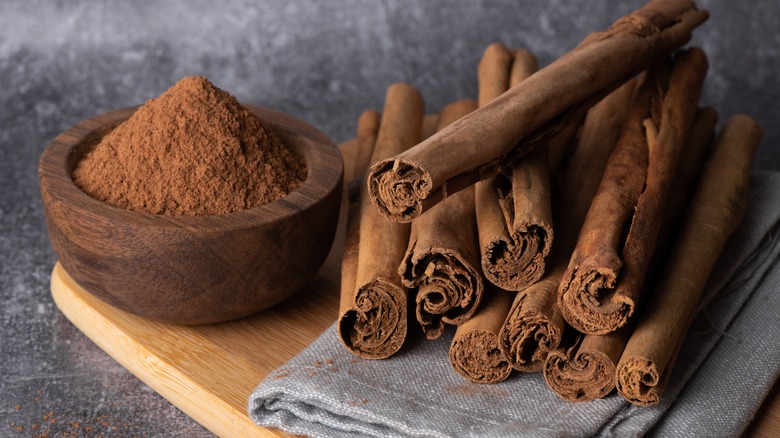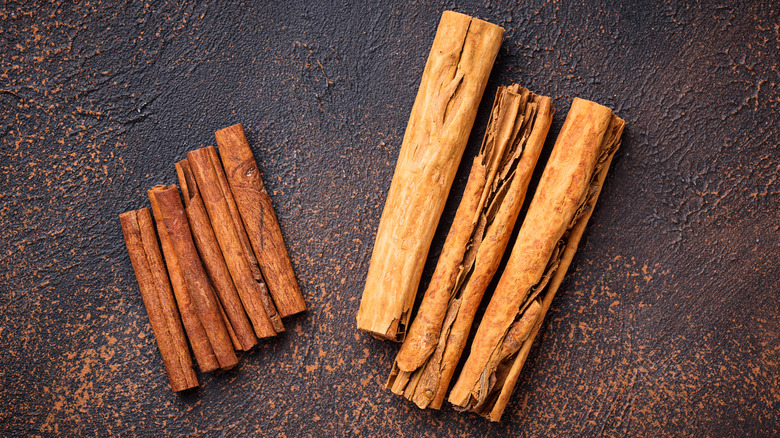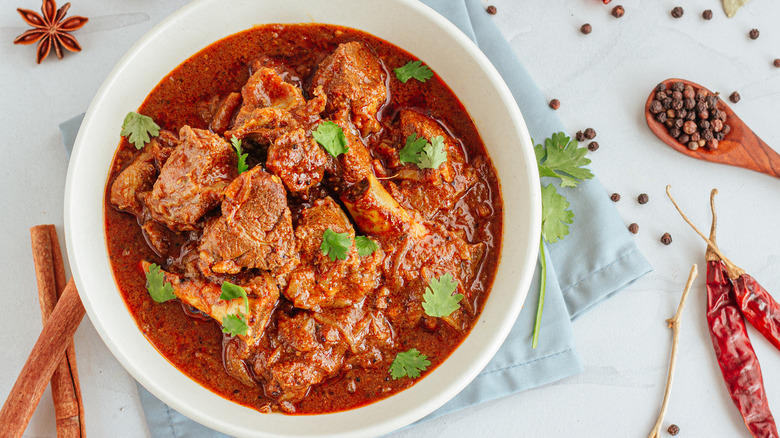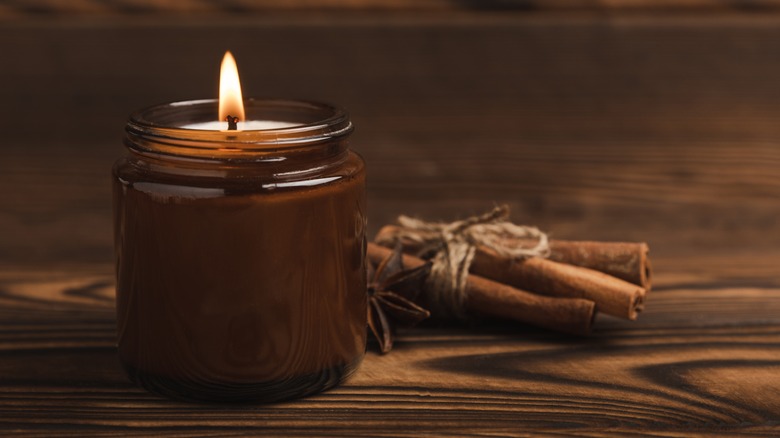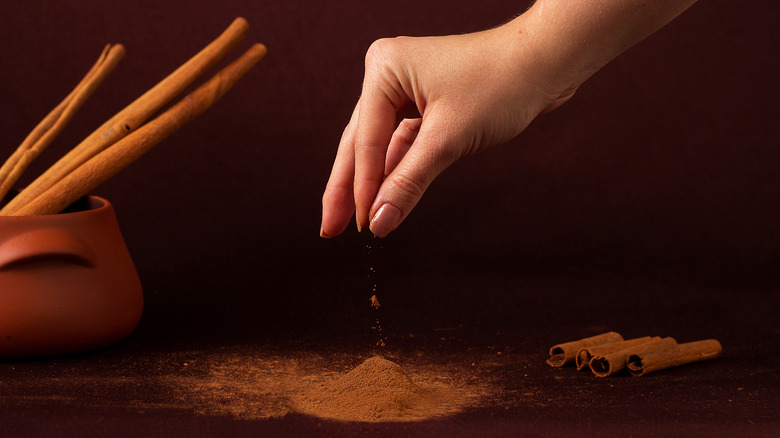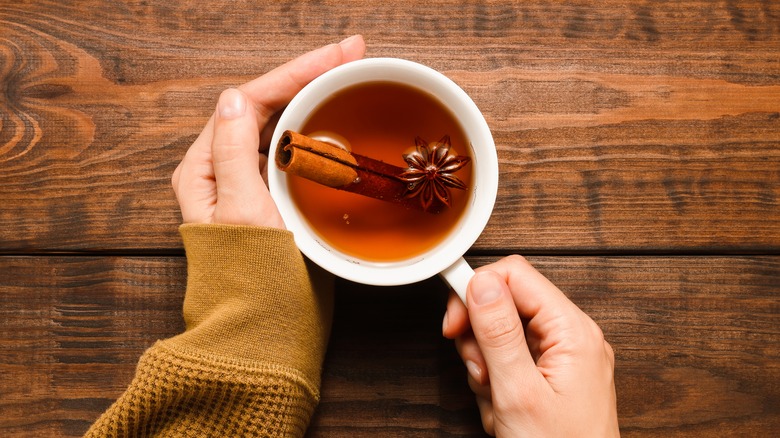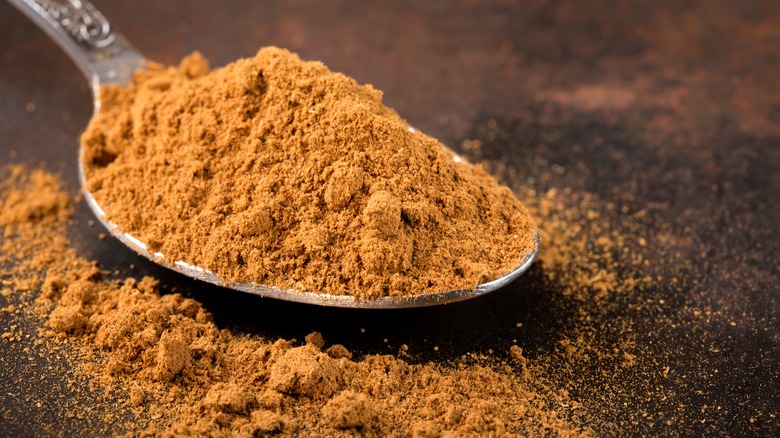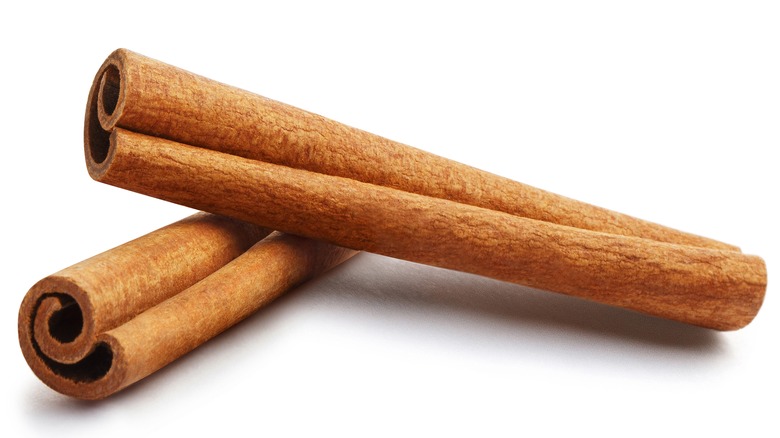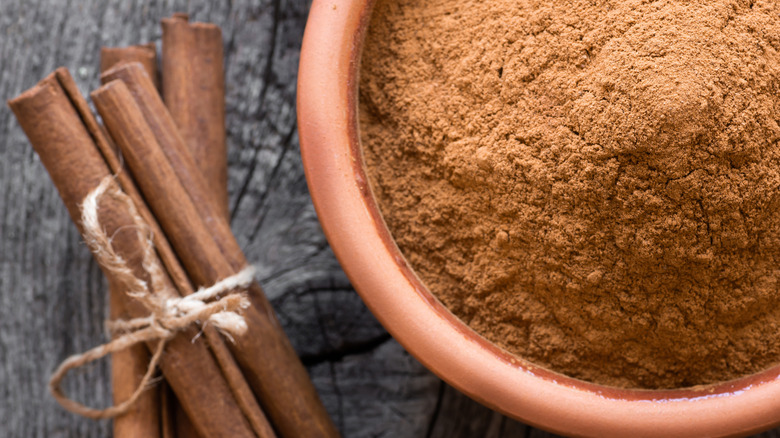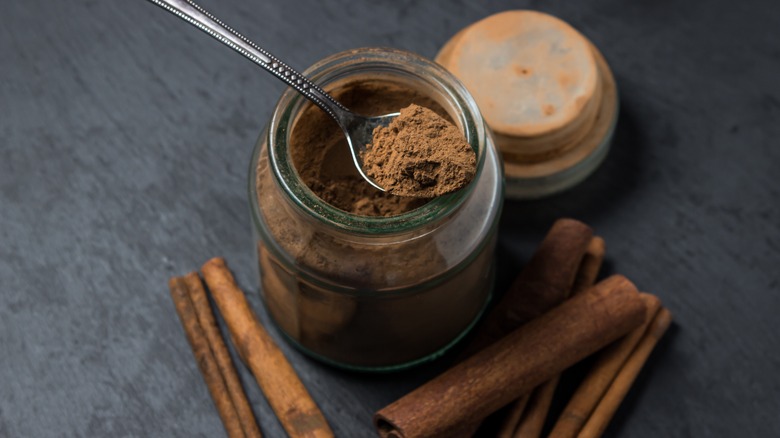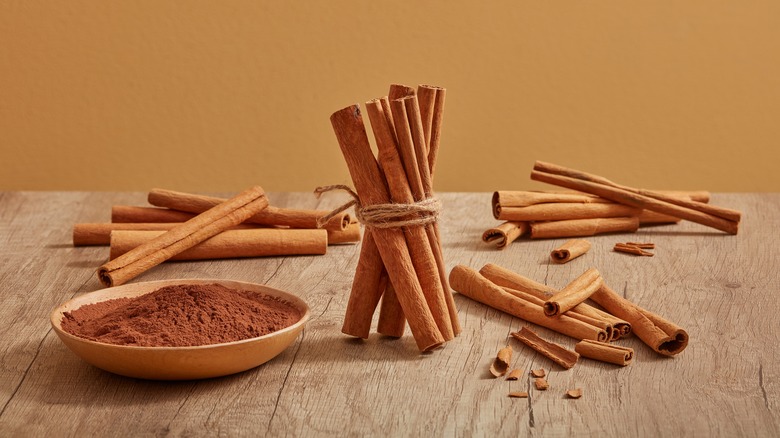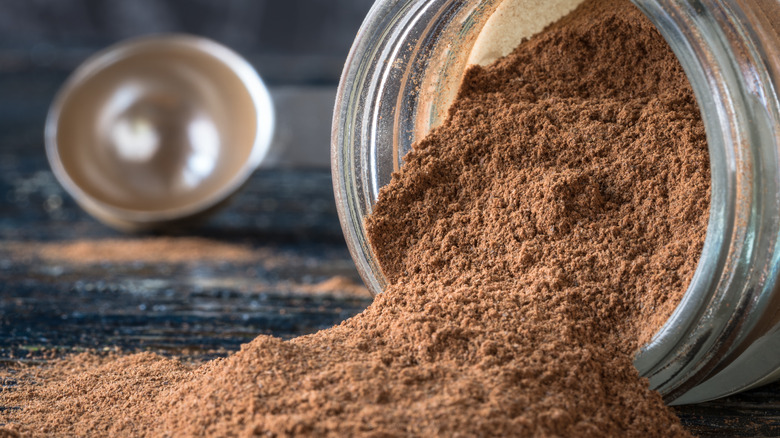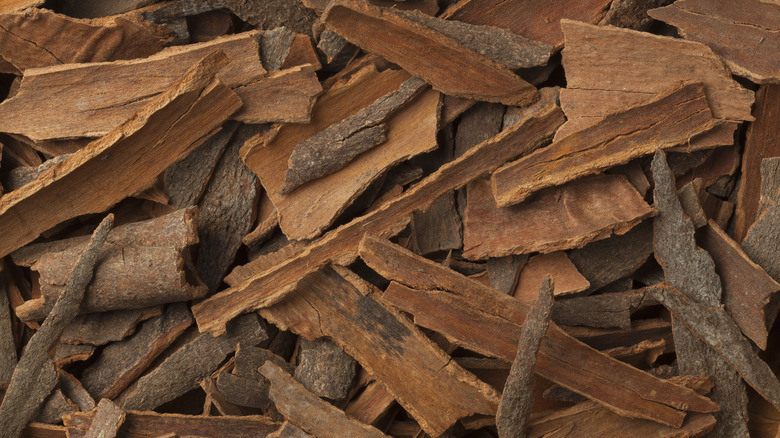False Facts About Cinnamon You Thought Were True
It's aromatic, it's sweet, and it's found just about everywhere in the world of food and drink. Cinnamon has charmed its way into our culinary consciousness, fitting as seamlessly into grandma's famous apple pie as it does into a trendy latte. With cinnamon's distinct flavor and warm aroma, it's easy to see how it has become one of the most cherished spices and a solid kitchen staple across the United States and beyond.
With cinnamon being such a frequently used spice, you might think you've learned all there is to know about this beloved ingredient. But, despite its popularity, misconceptions about cinnamon are common. This spice has more to it than first meets the eye, from its origins to health benefits and its applications both in and out of the kitchen. We've sifted through the facts and the fiction to bring you the truth behind the biggest cinnamon myths. So, read on, and you can be sure that next time you bite into a fluffy cinnamon roll, you'll be equipped with a newfound knowledge on this much-loved foodie staple.
False: There's only one type of cinnamon
Many people assume that all cinnamon is universally the same, but that is simply not the case. In fact, there are several varieties of cinnamon, each with its own distinct flavor profile and characteristics. The two most common types are Cassia cinnamon and Ceylon cinnamon.
Cassia cinnamon, derived from the Cinnamomum aromaticum tree, is the variety most commonly found in grocery stores and used in everyday cooking and baking. It has a strong, fragrant, and warm taste with hints of sweetness, making it perfect for adding aromatic flavor and cozy vibes to everything from cookies and oatmeal to curries and meat marinades. Sticks of Cassia cinnamon also tend to be rough and have a deep red-brown color.
In contrast, Ceylon cinnamon comes from the Cinnamomum verum tree, native to Sri Lanka (formerly known as Ceylon), and is considered by many as the true cinnamon. It has a paler color, softer texture, and more delicate, complex flavor, with subtle floral notes and a sweeter taste than Cassia cinnamon. Ceylon cinnamon is prized for its superior quality and is often used in gourmet cooking. While both types of cinnamon can add depth and warmth to a variety of dishes, experimenting with Ceylon cinnamon may introduce you to a whole new world of flavor. It's easy to get hold of online or in specialty stores, so it's certainly worth a try if your pantry currently contains only the Cassia variety.
False: Its uses are limited to sweet recipes
There's no question that cinnamon is a star ingredient in a plethora of sweet treats, from classic cinnamon rolls and spiced Brioche French toast to sweet snickerdoodle cookies and the coziest apple crisp. It's easy to immediately jump to desserts and bakes when we think of this spice, but cinnamon is a truly versatile ingredient, and its culinary applications are just as well placed in many savory dishes.
Cinnamon can be used to bring warmth and richness to an array of savory recipes such as beer chili, Vietnamese pho, slow-roasted pork, and Indian curries like chicken tikka masala. Its aromatic notes pair beautifully with meats like lamb, chicken, and beef, adding depth of flavor without overwhelming the dish. Additionally, cinnamon is a key component in many spice blends, such as garam masala and ras el hanout, which are used to season everything from soups and stews to grilled vegetables and rice.
Cinnamon has also found its way into beverages, both hot and cold. It adds a comforting warmth to hot drinks like mulled cider, chai tea, and hot chocolate while also lending a subtle sweetness to iced coffees, smoothies, juices, and cocktails.
False: It's only used as a foodstuff
While cinnamon is primarily known for its inclusion in cooking and baking, its applications extend far beyond the kitchen. If the taste doesn't tickle your fancy, have no fear. There are plenty of other ways to put this spice to good use.
Firstly, cinnamon has long been featured in aromatherapy for its calming and uplifting scent. The warm, spicy aroma of cinnamon is thought to promote relaxation, reduce stress, and improve mood. It is often included in essential oil blends, candles, and room sprays to create a cozy and inviting atmosphere.
Furthermore, cinnamon also acts as an effective natural preservative when added to cosmetics and household products. Its antimicrobial properties mean it helps to inhibit the growth of bacteria and fungi, making it a handy ingredient in the formulation of many goods, from skin-care products to air fresheners. Cinnamon can even be used as a tool for pest control. Placing a pouch containing cinnamon sticks in your drawers or wardrobe is thought to deter moths while a sprinkling of ground cinnamon can prevent ants from invading your home.
False: Adding cinnamon makes every recipe better
Cinnamon is undoubtedly a cherished spice, with its signature flavor featured in a seemingly endless array of desserts and baked goods. While there is good reason for its popularity, some argue that cinnamon is completely overused.
It's clear that America has a soft spot for cinnamon. You don't have to look far to find a recipe or product where the spice has been tossed in for good measure. But not everyone is on board with the craze. In a blog in The Guardian, boldly titled "Cinnamon stinks," food critic Jay Rayner writes, "What the hell is it with Americans and cinnamon? ... They cannot get enough of the stuff. It is everywhere and on everything." He goes on to rant about coffee shops and malls, where the sight and smell of the nation's favorite spice is deemed inescapable.
Perhaps there is too much of a notion that cinnamon automatically improves or fits into every recipe. It certainly packs a punch when it comes to both taste and aroma, as chef Srijith Gopinathan explains in an interview with Purewow: "People don't understand how careful you must be when using a strong spice. ... You can't let one spice overpower the other flavors of your dishes." While cinnamon can be a wonderful addition to certain sweet and savory dishes, it's important to use it with care and consider whether it complements the other flavors in the dish.
False: Its health benefits are minimal
Cinnamon isn't just a flavorful spice; it's also been valued for centuries for its medicinal properties and health benefits. Cinnamon contains a compound called cinnamaldehyde, which research suggests may contribute to its health-promoting properties. One of the most well-known benefits of cinnamon is its potential to help regulate blood sugar levels. Studies have shown that cinnamon may improve insulin sensitivity and reduce blood sugar levels, particularly in individuals with diabetes or insulin resistance. This effect is thought to be due to cinnamaldehyde's ability to mimic the action of insulin and improve glucose uptake by cells.
Additionally, cinnamon is prized for its antioxidant and anti-inflammatory properties. Antioxidants help protect the body from oxidative stress and may reduce the risk of chronic illness like heart disease and cancer. Cinnamon also contains compounds that have been shown to inhibit the production of inflammatory molecules in the body, which may help alleviate symptoms of conditions like rheumatoid arthritis and neurodegenerative diseases.
Cinnamon has also demonstrated strong antimicrobial properties. Cinnamon oil has been shown to inhibit the growth of bacteria and fungi, including those that can cause infections in the respiratory and digestive systems. So, cinnamon may be an incredibly valuable natural remedy when it comes to fighting infections and supporting overall immune health.
False: The cinnamon challenge is a good idea
The cinnamon challenge gained popularity on social media platforms in the early 2000s, when individuals attempted to swallow a spoonful of ground cinnamon without water in under 60 seconds. The challenge may have seemed like a harmless bit of fun to those taking it on, but it actually came with a whole lot of risks.
Attempting to swallow a large quantity of dry ground cinnamon can lead to a range of potential health problems. When ingested in its raw form and in such a large quantity, cinnamon can cause irritation and inflammation of the mouth, throat, and airways, leading to coughing, gagging, and difficulty breathing. There's also the risk of inhaling cinnamon particles into the lungs, which in severe cases can result in permanent scarring or aspiration pneumonia — a condition that can be life-threatening. If you have asthma, the challenge is even more of a no-no. Inhaling cinnamon could trigger an asthma attack, which has the potential to be fatal.
When it comes to cinnamon, we'd say stick to using it in moderation as a flavorful spice in your favorite recipes rather than risking your health for a fleeting moment of internet fame.
False: It comes from a flower
Like many spices, we tend to see cinnamon in its processed form — ground into a powder or presented in neat little sticks. But where does it come from and how does it grow?
Cinnamon is indeed derived from a plant, but it doesn't come from the flower, fruit, or leaf. In fact, the source of this aromatic spice is the inner bark of the cinnamon tree. There are several species of trees in the Cinnamomum genus, which grow in many parts of the world, including Indonesia, Sri Lanka, India, Vietnam, and Tanzania.
The process of harvesting cinnamon involves stripping away the outer bark of the tree to reveal the inner bark, which is then carefully peeled off in thin strips. These strips are then left to dry and curl into quills, which are the sticks we are familiar with. Ceylon cinnamon often comes in that characteristic stick form while Cassia cinnamon is more typically pre-ground into the fine powder that we use so commonly in cooking.
False: Cinnamon sticks are better than ground cinnamon
Cinnamon sticks seem to carry the connotation of being a more premium or flavorful product than ground cinnamon, but this isn't necessarily true. Both forms can offer the same delightful flavor, but each has its own advantages and best uses. It's not a matter of one being inherently better than the other, but rather a matter of which form is best suited to your needs.
Cinnamon sticks can be used whole or broken into smaller pieces, and one of their main advantages is their versatility. They can be used to infuse flavor into liquids like mulled wine, cider, or tea, where they slowly release their aromatic oils. Cinnamon sticks are also commonly used in pickling, braising, and slow-cooking dishes like stews and curries to impart a subtle warmth over time.
On the other hand, ground cinnamon offers convenience and ease of use. It is simply the powdered form of the same product and can be easily sprinkled or measured out for more precise seasoning in recipes. Ground cinnamon is perfect for baking, where it can be evenly distributed throughout the batter or dough to give a consistent flavor. It's also the best form for adding flavor and spice to oatmeal, yogurt, and other dishes without the need for steeping or simmering.
False: You can eat at much as you want
Because cinnamon is a delicious and healthful addition to your diet, you might not think there's any need to limit your intake. However, consuming excessive amounts of this spice could actually have negative consequences for your health.
One potential concern with consuming large quantities of cinnamon is its coumarin content. Coumarin is a natural compound found in cinnamon, with Cassia cinnamon containing much higher levels than the Ceylon variety. High levels of coumarin have been linked to liver and kidney damage and other health issues in some studies.
Research has established that the tolerable daily intake (TDI) of coumarin is 0.1 milligrams per kilogram of body weight. Therefore, consuming cinnamon in amounts that exceed this limit on a regular basis may increase the risk of adverse health effects. But what does that look like as a more tangible amount? Well, eating as little as one to two teaspoons of Cassia cinnamon a day could easily be enough exceed the recommend limit. Ceylon cinnamon is extremely unlikely to take you over the limit, as it contains 250 times less coumarin than Cassia. You'd have to eat a pretty huge amount! So, if you're a cinnamon fiend, sticking to Ceylon might be a good idea to prevent any adverse effects.
False: You can keep an opened jar of it indefinitely
How long ago did you buy that cinnamon in your spice rack? The answer may be quite some time ago. Cinnamon is known for being a pantry staple, and we often take the view that it can be stored indefinitely once opened. While it does keep well, like many spices, cinnamon is susceptible to degradation over time, particularly when stored incorrectly.
When cinnamon is exposed to air, heat, or light, the compounds that are responsible for its flavor and aroma can begin to degrade. Over time, this can result in a loss of potency and diminish the overall quality of the spice. Additionally, exposure to heat and moisture can cause cinnamon to clump together and harden. To ensure that your cinnamon retains its flavor and aroma for as long as possible, store it in an airtight container in a cool, dark, and dry place. This will help to preserve its quality.
While cinnamon doesn't necessarily spoil or become unsafe to consume over time, this loss of potency and flavor can make it less enjoyable to use in cooking and baking. To get the most out of your cinnamon and ensure optimal flavor and quality, it's best to use it within two to three years of purchase. This still gives you plenty of time to make all of your favorite cinnamon-infused recipes!
False: All cinnamon is created equal
We've know there are distinct differences between the two main varieties of cinnamon — Cassia and Ceylon, but is this the only factor we need to consider when selecting the spice? Well, depending on where you buy it and the brand you choose, the quality of cinnamon can vary significantly.
One common practice among some spice manufacturers is to add fillers to ground cinnamon to bulk it out and lower costs. These fillers can include everything from ground nut shells to an anti-caking agent. While this may seem harmless, it can dilute the flavor and aroma of the cinnamon and lower its overall quality. One study by scientists at the Indian Institute of Spices Research tested samples of widely available cinnamon. They found that a whopping seven out of 10 samples consisted of other substances that had been dyed to look like cinnamon and simply flavored with cinnamaldehyde (the compound found in cinnamon that gives it that distinctive smell and taste).
Some cinnamon brands may also use lower-grade cinnamon bark that contains less of the flavorful natural oils, meaning the final product has less potency. To ensure that you're getting the highest quality cinnamon, choose reputable brands that prioritize quality and purity. Another option to avoid fillers is to buy cinnamon sticks and grind them yourself in a spice or coffee grinder. Keep in mind that Ceylon cinnamon, which is more soft and crumbly, will be much easier to grind than the tougher Cassia variety.
False: Its rise to fame occurred in recent history
If you thought cinnamon's popularity was a recent phenomenon, you would be wrong. This aromatic spice has a rich history, with its uses actually dating back thousands of years.
In ancient times, cinnamon was a highly sought-after commodity and considered more valuable than gold. It was traded along ancient spice routes and used as a preservative, a medicine, and even as a form of currency. Cinnamon was truly a symbol of wealth and luxury among ancient civilizations. It's even thought that the ancient Egyptians used cinnamon as an antibacterial agent to prevent decay during the embalming process. During the Middle Ages, cinnamon continued to be highly prized in Europe, where it was used to treat ailments like coughs and sore throats, as well as a preservative for meats.
In more recent history, the world's love for cinnamon has only continued to grow, thanks to its widespread availability and uses in cooking and beyond. Today, it remains one of the most popular and versatile spices in the world, enjoyed by people from a variety of cultures.
False: The US is the largest consumer of cinnamon
Cinnamon is certainly a beloved spice in the United States, so it may come as a surprise to some that the country is not actually the largest consumer of cinnamon worldwide. For years, Indonesia was both the top consumer and producer of cinnamon globally, but its production levels have been surpassed by mainland China and Vietnam, according to 2022 figures from the Food and Agriculture Organization of the United Nations.
In the top cinnamon-consuming countries, it's an integral ingredient, used in everything from cooking to cosmetics and pharmaceutical products. Cassia cinnamon is the most popular form of the spice due to its lower cost and higher coumarin content — which is thought to give it some of the medicinal properties. However, prized for the more subtle and complex taste it gives when used in cooking, Ceylon cinnamon is particularly popular in Mexico, where it is often referred to as Mexican cinnamon.
